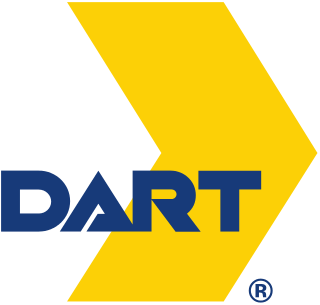
Dallas Area Rapid Transit (DART) is a transit agency serving the Dallas–Fort Worth metroplex of Texas. It operates buses, light rail, commuter rail, and high-occupancy vehicle lanes in Dallas and twelve of its suburbs. In 2023, the system had a ridership of 50,463,300, or about 166,900 per weekday as of the fourth quarter of 2023.

Carpooling is the sharing of car journeys so that more than one person travels in a car, and prevents the need for others to have to drive to a location themselves. Carpooling is considered a Demand-Responsive Transport (DRT) service

A vehicle for hire is a vehicle providing private transport or shared transport for a fee, in which passengers are generally free to choose their points or approximate points of origin and destination, unlike public transport, and which they do not drive themselves, as in car rental and carsharing. They may be offered via a ridesharing company.
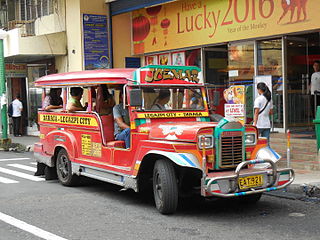
A share taxi is a mode of transport which falls between a taxicab and a bus. These vehicles for hire are typically smaller than buses and usually take passengers on a fixed or semi-fixed route without timetables, but instead departing when all seats are filled. They may stop anywhere to pick up or drop off their passengers. Often found in developing countries, the vehicles used as share taxis range from four-seat cars to minibuses. They are often owner-operated.

Paratransit or Intermediate Public Transport, is a type of transportation services that supplement fixed-route mass transit by providing individualized rides without fixed routes or timetables. Paratransit services may vary considerably on the degree of flexibility they provide their customers. At their simplest they may consist of a taxi or small bus that will run along a more or less defined route and then stop to pick up or discharge passengers on request. At the other end of the spectrum—fully demand responsive transport—the most flexible paratransit systems offer on-demand call-up door-to-door service from any origin to any destination in a service area. In addition to public transit agencies, paratransit services may be operated by community groups or not-for-profit organizations, and for-profit private companies or operators.
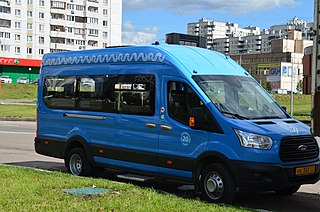
Marshrutnoye taksi, commonly known by the colloquialism Marshrutka, are share taxis found in Eastern Europe and the republics of the former Soviet Union. Usually vans, they drive along set routes, depart only when all seats are filled, and may have higher fares than buses. Passengers can board a marshrutka anywhere along its route if there are seats available.

The Rhode Island Public Transit Authority (RIPTA) provides public transportation, primarily buses, in the state of Rhode Island. The main hub of the RIPTA system is Kennedy Plaza, a large bus terminal in downtown Providence, Rhode Island. Average daily ridership as of the fourth quarter of 2023 is 41,800. The agency operates 59 fixed-route bus routes and 7 demand-responsive routes, together serving 37 out of 39 Rhode Island municipalities.
The Southwest Ohio Regional Transit Authority (SORTA) is the public transport agency serving Cincinnati and its Ohio suburbs. SORTA operates Metro fixed-route buses, bus rapid transit, microtransit, and paratransit services. SORTA's headquarters are located at the Huntington Building in Cincinnati’s Central Business District. The agency is managed by CEO and General Manager Darryl Haley along with a 13-member board of trustees. In 2023, the system had a ridership of 13,091,500, or about 44,800 per weekday as of the fourth quarter of 2023.

Chapel Hill Transit operates public bus and van transportation services within the contiguous municipalities of Chapel Hill and Carrboro and the campus of the University of North Carolina at Chapel Hill in the southeast corner of Orange County in the Research Triangle metropolitan region of North Carolina. Chapel Hill Transit operates its fixed route system fare free due to a contractual agreement with the two towns and the university to share annual operating and capital costs. In 2023, the system had a ridership of 3,855,400, or about 16,600 per weekday as of the fourth quarter of 2023.

Marin Transit is a public bus agency in Marin County, California, in the United States. Originally formed in 1964 as Marin County Transit District (MCTD). Marin Transit was re-branded on 30 July 2007 and now provides a variety of fixed-route and demand-response services using contractors. In 2023, the system had a ridership of 2,814,700, or about 8,800 per weekday as of the fourth quarter of 2023.
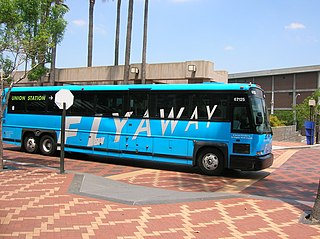
An airport bus, or airport shuttle bus or airport shuttle or Shuttle Bus is a bus used to transport people to and from, or within airports. These vehicles will usually be equipped with larger luggage space, and incorporate special branding. They are also commonly painted with bright colours to stand out among other airport vehicles and to be easily seen by the crews of taxiing aircraft when negotiating the aprons.
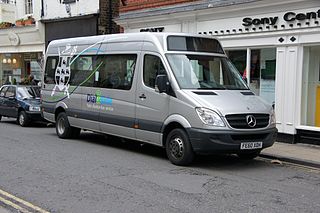
A Telebus, Dial-a-bus, or Dial-a-ride service is a bus service that operates in a mode partway between a normal scheduled bus service and a taxi; it is a form of demand responsive transport. Telebuses typically have a scheduled route, but passengers can ring and book a pick-up within an area served by the route, and the bus route is modified to make the pick-up. Drop offs anywhere within the area can also be accommodated. The aim is to extend public transport services to the front door of all residences, or from any place to any place.

Shared transport or shared mobility is a transportation system where travelers share a vehicle either simultaneously as a group or over time as personal rental, and in the process share the cost of the journey, thus purportedly creating a hybrid between private vehicle use and mass or public transport. It is a transportation strategy that allows users to access transportation services on an as-needed basis. Shared mobility is an umbrella term that encompasses a variety of transportation modes including carsharing, Bicycle-sharing systems, ridesharing companies, carpools, and microtransit.
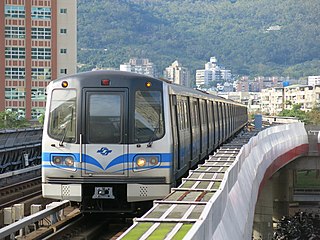
Public transport is a system of transport for passengers by group travel systems available for use by the general public unlike private transport, typically managed on a schedule, operated on established routes, and that may charge a posted fee for each trip. There is no rigid definition of which kinds of transport are included, and air travel is often not thought of when discussing public transport—dictionaries use wording like "buses, trains, etc." Examples of public transport include city buses, trolleybuses, trams and passenger trains, rapid transit and ferries. Public transport between cities is dominated by airlines, coaches, and intercity rail. High-speed rail networks are being developed in many parts of the world.

The public light bus (PLB) or minibus is a public transport service in Hong Kong. It uses minibuses to provide quicker transport and to serve areas that standard Hong Kong bus lines cannot reach as efficiently. The vehicles are colloquially known by the code-switch Van仔.
BRIDJ is a SaaS platform designed to support ‘demand responsive’ or ‘on demand’ public transport providers. The platform allows a user to optimise an on-road service and digitise work processes, and includes an optimisation engine, traveller app, driver app and client portal. The traveller app allows passengers to book, pay and track a service between two locations within a service area. The optimisation engine consumes pre-planned and real-time bookings and then allocates passengers to the available vehicles to create the optimal trips for the given service objectives. The optimisation engine is designed to handle large numbers of passengers and vehicles of both small capacities and high capacity (6-50+). BRIDJ technology is currently deployed on public transport services in both Sydney and Adelaide, Australia and for transfer services Singapore.

Via Transportation, Inc. provides software as a service (SaaS) and mobility as a service to operators of public transportation, multimodal transport, paratransit operations in compliance with laws such as the Americans with Disabilities Act of 1990, non-emergency medical transportation, logistics and deliveries, school bus fleets, commercial ridesharing and corporate shuttles, and autonomous vehicles. Its customers include cities, transportation authorities, government entities, school districts, universities, and private organizations worldwide. It was founded in 2012 and is headquartered in New York City.

Microtransit is a form of bus demand responsive transport vehicle for hire. This transit service offers a highly flexible routing and/or highly flexible scheduling of minibus vehicles shared with other passengers. Microtransit providers build routes ad-hoc exclusively to match only each demand (trip) and supply and to extend the efficiency and accessibility of the transit service. Possible pick-up/drop-off stops are restricted, and transit can be provided as a stop-to-stop service or a curb-to-curb service.

Fflecsi is a trial demand-responsive bus service administered by Transport for Wales (TfW) and local authorities, operated by local bus operators across Wales. Pilot trials of the service are conducted across Wales, which included a city-wide trial in Newport until September 2022. The effectiveness of the service is being monitored as full bus services resume in Wales during the COVID-19 pandemic. During the pilots, fflecsi will replace some pre-existing scheduled bus routes in the service areas where it operates. The technology behind the service is made by ViaVan, and the pilot is funded by the Welsh Government, to invest in new approaches to public transport in Wales as part of their Llwybr Newydd strategy. The pilot was included in Welsh Labour's manifesto for the 2021 Senedd election, as part of their plan to increase investment in bus services, and reducing Wales' carbon emissions.
Buses play a major role in the public transport of Malaysia, as well as seeing extensive private use. While rail transport has increased over the recent years due to road congestion, the same does not apply to buses, which have generally been used less in most of the area.




















